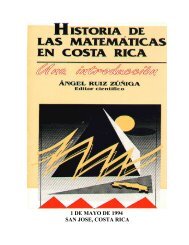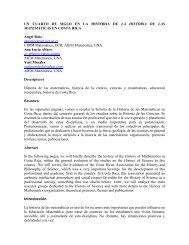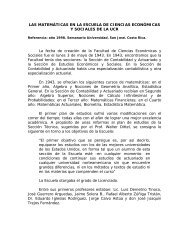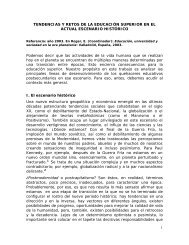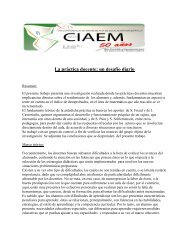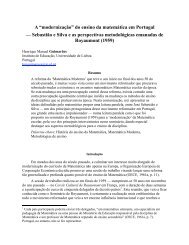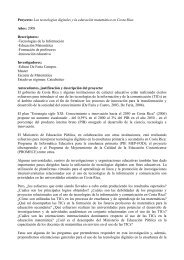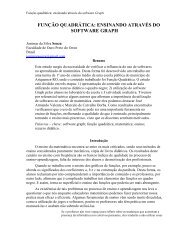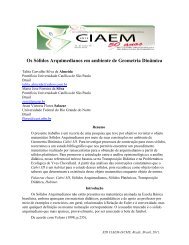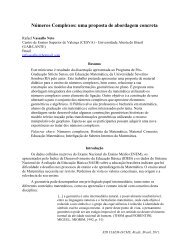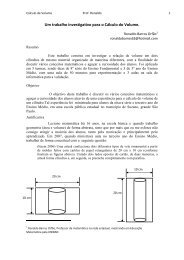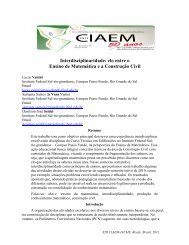Reform of the construction of the number system with ... - CIMM
Reform of the construction of the number system with ... - CIMM
Reform of the construction of the number system with ... - CIMM
You also want an ePaper? Increase the reach of your titles
YUMPU automatically turns print PDFs into web optimized ePapers that Google loves.
36 H. Griesel<br />
jectively <strong>the</strong> results <strong>of</strong> a measurement (in <strong>the</strong> sense <strong>of</strong> a<br />
multiplicative comparison <strong>of</strong> two values <strong>of</strong> a quantity).<br />
In brief (Griesel, 2003): Numbers are comparison<br />
results <strong>of</strong> measuring.<br />
This is a concept <strong>of</strong> <strong>number</strong> which considers all<br />
kinds <strong>of</strong> <strong>number</strong>s – natural, positive rational, integer,<br />
real, irrational, even complex <strong>number</strong>s – under a<br />
homogenous aspect. A fundamental change <strong>of</strong> <strong>the</strong><br />
conceptual content which was found in Frege’s considerations<br />
and which leads to difficulties in school<br />
curricula, is avoided.<br />
The single kinds <strong>of</strong> <strong>number</strong>s come from <strong>the</strong> application<br />
<strong>of</strong> <strong>the</strong> measuring procedure to different measuring<br />
<strong>system</strong>s (Griesel, 2006). The measuring <strong>system</strong><br />
<strong>of</strong> <strong>the</strong> natural <strong>number</strong>s is <strong>the</strong> class <strong>of</strong> finite sets. The<br />
measuring procedure consists <strong>of</strong> counting out a finite<br />
set, that is a multiplicative comparison <strong>of</strong> a finite set<br />
<strong>with</strong> sets <strong>of</strong> only one element. Natural <strong>number</strong>s are in<br />
this sense primarily counting <strong>number</strong>s (Bedürftig and<br />
Murowski, 2001).<br />
The measuring <strong>system</strong>s <strong>of</strong> <strong>the</strong> positive rational<br />
<strong>number</strong>s are <strong>the</strong> divisible quantity domains (in <strong>the</strong><br />
sense <strong>of</strong> Kirsch, 1970) and <strong>of</strong> <strong>the</strong> positive real <strong>number</strong>s<br />
<strong>the</strong> complete quantity domains.<br />
The measuring <strong>system</strong>s <strong>of</strong> <strong>the</strong> positive and negative<br />
<strong>number</strong>s are <strong>the</strong> Cartesian products <strong>of</strong> a quantity domain<br />
<strong>with</strong> a one-dimensional direction characteristic.<br />
The latter is a set <strong>with</strong> two elements (such as to <strong>the</strong><br />
right, to <strong>the</strong> left; orforward, backward; orup, down; or<br />
increase, decrease; etc.). The measuring quotient is<br />
defined for such a set: x=y ¼ 1ifx = y;<br />
x=y ¼ 1ifx 6¼ y, where 1 and –1 are <strong>the</strong> two elements<br />
<strong>of</strong> <strong>the</strong> cyclic group <strong>of</strong> <strong>the</strong> order 2 (Griesel, 2003).<br />
Notice for this purpose that <strong>the</strong> multiplicative group <strong>of</strong><br />
<strong>the</strong> positive and negative real <strong>number</strong>s is <strong>the</strong> direct<br />
product <strong>of</strong> <strong>the</strong> group <strong>of</strong> order 2 <strong>with</strong> <strong>the</strong> multiplicative<br />
group <strong>of</strong> <strong>the</strong> positive real <strong>number</strong>s.<br />
As already mentioned it would have been more<br />
consistent if Frege had demanded not only <strong>the</strong> application<br />
<strong>of</strong> <strong>number</strong>s for measuring but also that <strong>the</strong><br />
application <strong>of</strong> multiplication and addition for measuring<br />
should be involved in <strong>the</strong>ir definition. Condition (1)<br />
in <strong>the</strong> definition <strong>of</strong> quantity (x/y) (y/z) =x/z shows<br />
<strong>the</strong> way how this might be achieved. Multiplication <strong>of</strong><br />
<strong>number</strong>s has to be defined by chaining <strong>of</strong> measurements.<br />
A definition <strong>of</strong> multiplication on this basis could<br />
look as follows: a b = c, for which is valid: Let a = x/y<br />
and b = y/z <strong>the</strong>n c = x/z.<br />
It must still be shown that this definition is independent<br />
from <strong>the</strong> choice <strong>of</strong> x, y, z. It is in particular<br />
emphasized that this definition is valid for all kinds <strong>of</strong><br />
<strong>number</strong>s. It is a universal, application-oriented definition<br />
<strong>of</strong> multiplication <strong>with</strong> ontological commitments.<br />
123<br />
4.4 Specification <strong>of</strong> <strong>the</strong> concepts <strong>of</strong> interval-scale<br />
and additive measuring<br />
In <strong>the</strong> following definition <strong>the</strong> concept <strong>of</strong> interval-scale<br />
is specified toge<strong>the</strong>r <strong>with</strong> <strong>the</strong> concept <strong>of</strong> additive measuring.<br />
Similar to <strong>the</strong> concept <strong>of</strong> quantity an intervalscale<br />
is a mapping <strong>with</strong> a set <strong>of</strong> objects as <strong>the</strong> domain <strong>of</strong><br />
this mapping and <strong>the</strong> set <strong>of</strong> values as <strong>the</strong> range <strong>of</strong> <strong>the</strong><br />
mapping. To every interval-scale is associated a quantity<br />
Q.<br />
4.5 Definition <strong>of</strong> an interval-scale<br />
A mapping <strong>with</strong> <strong>the</strong> domain T, <strong>the</strong> range V and <strong>the</strong><br />
associated quantity Q is an interval-scale iff additionally<br />
an operation – is defined in <strong>the</strong> range <strong>with</strong> values<br />
in <strong>the</strong> set <strong>of</strong> values <strong>of</strong> <strong>the</strong> quantity Q, which fulfils <strong>the</strong><br />
following conditions:<br />
ðx yÞþðy zÞ ¼x z, for all x; y; z 2 V ð1 Þ<br />
ðx yÞ ¼0 ) x ¼ y; for all x; y 2 V ð2 Þ<br />
It can be proved that this definition is equivalent to<br />
<strong>the</strong> classical definition <strong>of</strong> an interval-scale given by<br />
Stevens (1946).<br />
The elements <strong>of</strong> T are called <strong>the</strong> objects <strong>of</strong> <strong>the</strong><br />
interval-scale. The elements <strong>of</strong> <strong>the</strong> set V are called <strong>the</strong><br />
values <strong>of</strong> <strong>the</strong> interval-scale. The operation – is called<br />
additive measuring or <strong>the</strong> measuring difference.<br />
x – y = a is read: x additive measured <strong>with</strong> y equals a.<br />
x is compared additively <strong>with</strong> y. The result a is a value<br />
<strong>of</strong> <strong>the</strong> quantity which is associated <strong>with</strong> <strong>the</strong> intervalscale.<br />
It is spoken <strong>of</strong> <strong>the</strong> additive measurement x – y<br />
<strong>with</strong> <strong>the</strong> result a. The two additive measurements x – y<br />
and y – z can be chained because y is in both additive<br />
measurements (in <strong>the</strong> second and in <strong>the</strong> first place,<br />
respectively). The result is x – z. The chaining <strong>of</strong> x–y<br />
<strong>with</strong> y – z is x – z. Condition (1*) (x – y) +(y –z)=<br />
x – z shows that if <strong>the</strong> additive measurements (x – y)<br />
and (y – z) are chained becoming x – z, <strong>the</strong>n <strong>the</strong> results<br />
are added. Addition <strong>of</strong> quantity values and<br />
chaining <strong>of</strong> measurements are associated closely toge<strong>the</strong>r.<br />
This is important for <strong>the</strong> following considerations<br />
about <strong>the</strong> addition.<br />
4.6 Application-oriented introduction <strong>of</strong> addition<br />
Addition can be introduced, correspondingly to multiplication,<br />
according to condition (1*) <strong>with</strong> <strong>the</strong> help <strong>of</strong><br />
<strong>the</strong> chaining <strong>of</strong> additive measurements. However, it is<br />
an addition <strong>of</strong> quantity values ra<strong>the</strong>r than an addition<br />
<strong>of</strong> pure real <strong>number</strong>s.




